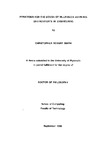Paradigms for the design of multimedia learning environments in engineering
| dc.contributor.supervisor | Jagodzinski, Peter | |
| dc.contributor.author | Smith, Chrisopher Robert | |
| dc.contributor.other | School of Engineering, Computing and Mathematics | en_US |
| dc.date.accessioned | 2011-05-10T13:08:26Z | |
| dc.date.available | 2011-05-10T13:08:26Z | |
| dc.date.issued | 1996 | |
| dc.identifier | Not available | en_US |
| dc.identifier.uri | http://hdl.handle.net/10026.1/342 | |
| dc.description.abstract |
The starting point for this research was the belief that interactive multimedia learning environments represent a significant evolution in computer based learning and therefore their design requires a re-examination of the underlying principles of learning and knowledge representation. Current multimedia learning environments (MLEs) can be seen as descendants of the earlier technologies of computer-aided learning (CAL), intelligent tutoring systems (ITS) and videodisc-based learning systems. As such they can benefit from much of the wisdom which emerged from those technologies. However, multimedia can be distinguished from earlier technologies by its much greater facility in bringing to the learner high levels of interaction with and control over still and moving image, animation, sound and graphics. Our intuition tells us that this facility has the potential to create learning environments which are not merely substitutes for "live" teaching, but which are capable of elucidating complex conceptual knowledge in ways which have not previously been possible. If the potential of interactive multimedia for learning is to be properly exploited then it needs to be better understood. MLEs should not just be regarded as a slicker version of CAL, ITS or videodisc but a new technology requiring a reinterpretation of the existing theories of learning and knowledge representation. The work described in this thesis aims to contribute to a better understanding of the ways in which MLEs can aid learning. A knowledge engineering approach was taken to the design of a MLE for civil engineers. This involved analysing in detail the knowledge content of the learning domain in terms of different paradigms of human learning and knowledge representation. From this basis, a design strategy was developed which matched the nature of the domain knowledge to the most appropriate delivery techniques. The Cognitive Apprenticeship Model (CAM) was shown to be able to support the integration and presentation of the different categories of knowledge in a coherent instructional framework. It is concluded that this approach is helpful in enabling designers of multimedia systems both to capture and to present a rich picture of the domain. The focus of the thesis is concentrated on the domain of Civil Engineering and the learning of concepts and design skills within that domain. However, much of it could be extended to other highly visual domains such as mechanical engineering. Many of the points can also be seen to be much more widely relevant to the design of any MLE. | en_US |
| dc.description.sponsorship | Engineering and Physical Sciences Research Council | en_US |
| dc.language.iso | en | en_US |
| dc.publisher | University of Plymouth | en_US |
| dc.title | Paradigms for the design of multimedia learning environments in engineering | en_US |
| dc.type | Thesis | |
| dc.identifier.doi | http://dx.doi.org/10.24382/4694 | |
| dc.identifier.doi | http://dx.doi.org/10.24382/4694 |
Files in this item
This item appears in the following Collection(s)
-
01 Research Theses Main Collection
Research Theses Main


